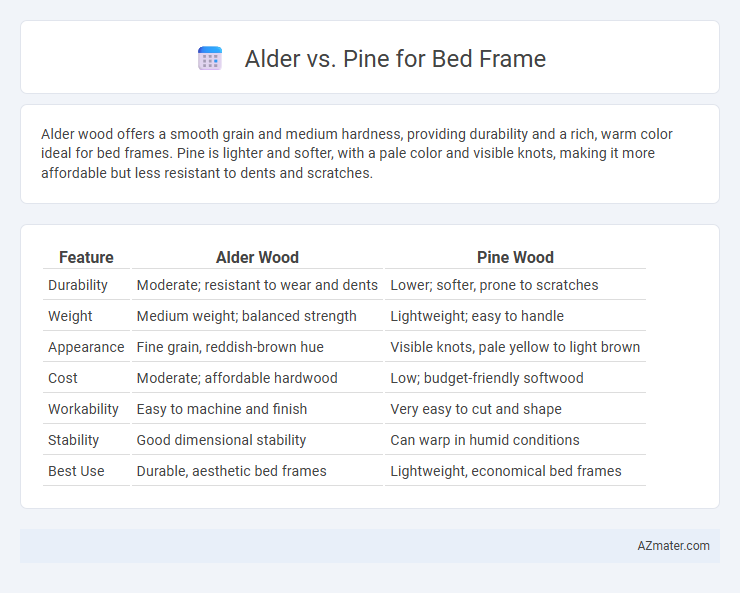Alder wood offers a smooth grain and medium hardness, providing durability and a rich, warm color ideal for bed frames. Pine is lighter and softer, with a pale color and visible knots, making it more affordable but less resistant to dents and scratches.
Table of Comparison
| Feature | Alder Wood | Pine Wood |
|---|---|---|
| Durability | Moderate; resistant to wear and dents | Lower; softer, prone to scratches |
| Weight | Medium weight; balanced strength | Lightweight; easy to handle |
| Appearance | Fine grain, reddish-brown hue | Visible knots, pale yellow to light brown |
| Cost | Moderate; affordable hardwood | Low; budget-friendly softwood |
| Workability | Easy to machine and finish | Very easy to cut and shape |
| Stability | Good dimensional stability | Can warp in humid conditions |
| Best Use | Durable, aesthetic bed frames | Lightweight, economical bed frames |
Introduction to Alder and Pine Wood
Alder wood is a hardwood known for its smooth texture and warm, reddish-brown hue, making it a popular choice for furniture like bed frames due to its durability and ease of staining. Pine wood, a softwood with a light yellowish tone and prominent knots, offers affordability and lightweight properties while maintaining sufficient strength. Both woods provide unique aesthetic and structural qualities, with alder favoring a richer finish and pine prioritizing a rustic, natural look.
Wood Characteristics: Alder vs Pine
Alder wood is known for its fine, straight grain and smooth texture, making it ideal for furniture like bed frames that require a refined appearance and easy finishing. Pine features more prominent knots and a softer texture, which gives it a rustic look but may dent or scratch more easily under heavy use. Both woods are lightweight and affordable, but alder generally offers greater stability and resistance to warping compared to pine in bedroom furniture applications.
Strength and Durability Comparison
Alder wood offers moderate strength and a smooth finish, making it suitable for bed frames with a balanced durability profile, while pine wood, though softer, provides excellent shock resistance and flexibility, reducing the risk of cracking under pressure. Pine's natural resin content enhances its resistance to wear and impact, whereas alder tends to be more prone to dents and scratches over time. For long-lasting bed frames, pine generally outperforms alder in durability due to its ability to absorb stress and recover from minor damages.
Aesthetic Appeal and Grain Patterns
Alder wood offers a warm, reddish-brown hue with a smooth, consistent grain pattern prized for its natural rustic charm, making it ideal for cozy and inviting bed frames. Pine features a lighter, yellowish tone with prominent knots and a more pronounced grain, perfect for a casual, country-style aesthetic. Both woods provide distinctive visual textures, with alder leaning towards elegance and pine emphasizing a more relaxed, natural look.
Workability and Ease of Crafting
Alder is known for its smooth grain and softness, making it easier to shape and carve with hand tools, ideal for detailed bed frame designs. Pine, being slightly softer and more lightweight, offers excellent workability and is forgiving for beginners, though it may dent or scratch more easily during crafting. Both woods allow for easy sanding and finishing, but alder's uniform texture provides a more refined surface for staining and painting.
Cost Differences: Alder vs Pine
Alder wood typically costs more than pine due to its durability and attractive grain patterns, making it a premium choice for bed frames. Pine is generally more affordable, widely available, and easier to work with, resulting in lower overall costs for construction. Choosing between alder and pine for a bed frame depends on budget preferences and desired aesthetic qualities.
Sustainability and Environmental Impact
Alder wood is more sustainable than pine due to its faster growth rate and ability to regenerate quickly in managed forests, reducing deforestation impact. Pine, while widely available, often requires pesticide use and intensive logging practices that can lead to habitat disruption and soil degradation. Choosing alder for a bed frame supports environmentally responsible forestry and lowers the carbon footprint associated with wood production.
Maintenance and Longevity
Alder bed frames require minimal maintenance due to their smooth grain and natural resistance to moisture, making them less prone to warping over time. Pine bed frames need regular care such as sealing or varnishing to prevent dents, scratches, and moisture damage, which can shorten their lifespan. Overall, alder offers greater longevity with less upkeep compared to pine, ensuring a durable and low-maintenance bed frame.
Common Uses in Bed Frame Construction
Alder wood is favored for bed frames due to its smooth grain, affordability, and ease of staining, making it ideal for rustic and traditional designs. Pine is commonly used in bed frame construction because of its lightweight nature, availability, and ability to hold paint or finishes well, fitting both modern and classic aesthetics. Both woods offer durability, but pine tends to be softer, requiring careful maintenance to avoid dents and scratches in bedroom furniture.
Which Wood is Best for Your Bed Frame?
Alder offers a smooth texture with a warm, reddish-brown hue that ages gracefully, making it ideal for bed frames requiring a rustic yet refined look. Pine is a softer wood with a lighter color and more prominent knots, providing a cost-effective option but may dent or scratch more easily over time. For a durable, elegant bed frame, alder is best suited due to its strength and resistance to wear, whereas pine suits budget-conscious buyers seeking a casual, natural appearance.

Infographic: Alder vs Pine for Bed Frame
 azmater.com
azmater.com